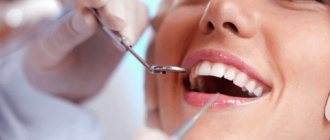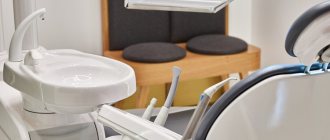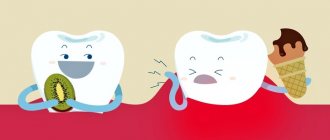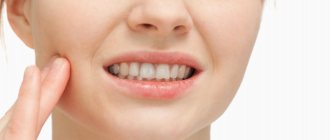Increased sensitivity of teeth (hyperesthesia) is a short-term occurrence of pain under the influence of temperature, chemical or mechanical irritating factors. Usually occurs when drinking cold water, sour, sweet, salty, or touching with a toothbrush. The intensity of pain varies from mild to unbearable.
According to WHO, every second person in the world suffers from hypersensitivity. In Russia it is about the same: 45–65% of adults aged 20–55 years. More often women make complaints.
A little anatomy
A tooth consists of a crown and root part, connected by a neck. The coronal part is covered with enamel, the root part is covered with cement. Beneath the enamel and cement there is dentin, a hard tissue. Inside there is soft tissue - the pulp; blood vessels and nerves pass through it.
Dentin is not sensitive, but consists of many tubules in which fluid circulates. The irritant causes fluid movement, which is detected by the nerve endings of the pulp. A person feels their reaction as pain.
Tooth sensitivity: causes
- Demineralization of enamel. It becomes more loose due to the leaching of calcium, phosphorus, and other trace elements.
- Thinning of enamel. As a result of increased abrasion due to malocclusion and the occurrence of wedge-shaped defects.
- Untreated caries or violation of the marginal seal of the filling.
- Exposure of roots as a result of injury, metabolic-dystrophic process or inflammation of the gums.
- Changes in the pH of saliva due to the consumption of certain drinks, foods, and medications. A pH of less than 5.5 is considered dangerous.
- Some diseases accompanied by gastroesophageal reflux and endocrine disorders.
- Vitamin deficiency, exposure to radiation, work in hazardous industries, living in a region with an unfavorable environmental situation.
- Smoking.
More often than not, several reasons are discovered at once. The enamel becomes thinner, loses strength, and cannot protect dentin from irritants. The result is pain.
Complications
Like any disease of the oral cavity, hypersensitivity has dangerous consequences. In advanced conditions, teeth can be lost as a result of caries or periodontitis. Even if the teeth are intact, hyperesthesia leads to a violation of the diet. Patients tend to exclude many foods and chew food poorly. This leads to the development of somatic diseases and can cause vitamin deficiency.
The most severe complication is inflammation of the pulp
– neurovascular bundle, which is often called simply “nerve”. This is a difficult disease to treat and can lead to pulp removal. This, in turn, deprives the tooth of nutrition and makes it fragile.
Provoking factors
Hyperesthesia does not appear immediately. There are several factors that you need to pay attention to in order to eliminate them in time. Don't wait for discomfort to appear. It is better to initially develop healthy habits that will help you maintain your health so that you never experience acute dental pain. Sensitivity increases when any of the factors listed below are present.
- Insufficient oral hygiene. Soft plaque is an accumulation of microbes that eat food microparticles stuck in crevices, releasing organic acids that dissolve enamel minerals. Externally, the dental unit looks intact, but the density of the enamel is significantly reduced. Its demineralization occurs. The first alarm bell is increased sensitivity, then caries develops.
- Consumption of certain foods. Juices, wine, sweet soda, fruits, candies, and other sweets contain phosphoric and other acids that negatively affect the strength of enamel.
- Constant use of aggressive whitening pastes containing abrasive and chemical components.
- Ultrasonic cleaning. Under a dense coating, the enamel becomes thinner and becomes loose. After professional cleaning, it is exposed, its sensitivity increases sharply. Usually, dentists, taking this point into account, use strengthening pastes at the end of the procedure for the preventive treatment of tooth sensitivity.
Types of hypersensitivity
If sensitivity is increased on one or more teeth, it is called limited. If for everyone - generalized.
Table 1. Types of hyperesthesia
| № | View | Reaction |
| 1. | Light | for cold, hot |
| 2. | Average | as with 1st degree plus for sour, sweet, salty |
| 3. | Expressed | as in grade 2 plus mechanical irritants (when brushing teeth, eating) |
How does dental hypersensitivity manifest?
A person will immediately recognize that tooth sensitivity has increased. The main symptom is acute short-term pain lasting 10-30 seconds. Pain may occur locally or affect the entire dentition.
Doctors distinguish three stages of hyperesthesia:
- The first is tooth sensitivity to hot/cold;
- The second is a reaction to changes in acidity: sweet, salty, spicy;
- Third, teeth react to any irritants, including light touches.
Sensitivity of teeth. Stages of treatment
- Eliminate the cause of hyperesthesia: get rid of plaque, deposits, stones, caries, wedge-shaped defects.
- Carry out professional oral hygiene.
- Strengthen the enamel with calcium and fluoride.
- Teach the patient how to use a toothbrush and floss correctly.
- Choose suitable dental care products: toothpaste, mouthwash.
Table 2. Tooth sensitivity: causes and how to treat
| № | Cause | What to do |
| 1. | Soft coating. | Careful hygiene with home remedies. |
| 2. | Hard coating. | Professional hygiene in dentistry. |
| 3. | Caries in the white spot stage. | Deep fluoridation, remineralization. |
| 4. | Caries, pulpitis, periodontitis. | Dental treatment. |
| 5. | Exposure of the cervical part, wedge-shaped defect. | |
| 6. | Malocclusion. | Orthodontic therapy. |
Treatment at the dentist
In most cases, hyperesthesia is caused by dental diseases. Therefore, it is not possible to get rid of the problem using home remedies or traditional medicine advice. In this case, home measures only aggravate the course of the pathology and lead to the progression of dental diseases.
You should not postpone a visit to the dentist even if there are minor manifestations of pain due to external stimuli. Modern medicine has effective methods for treating any dental ailment. After a thorough diagnosis of the condition of the teeth, an experienced specialist will accurately determine the cause of increased sensitivity and carry out the necessary treatment. This may be the elimination of wedge-shaped tooth defects, treatment of caries, periodontitis, pulpitis or erosion of tooth enamel. In the absence of serious diseases, the dentist can perform a competent procedure for remineralization of teeth, which will strengthen tooth enamel and relieve hypersensitivity.
Hypersensitivity is not a dental disease, but rather a symptom indicating the presence of dental disease. And the sooner you contact a specialist, the greater the chance of maintaining the health and integrity of your teeth.
Elimination of tooth sensitivity
Using ultrasound, the doctor removes soft and hard deposits from the teeth. After removing plaque, teeth become more sensitive for a short time, so remineralization or deep fluoridation is immediately carried out. During remineralization, the enamel is treated with active compounds of calcium and phosphates. Deep fluoridation – coating with sodium fluoride. Both procedures significantly strengthen the enamel's resistance to irritants.
The doctor uses agents that reduce the movement of fluid in the dentinal tubules. It “seals” them using desensitizers or reduces their volume through remineralization. Protecting exposed dentin reduces the force of transmission of the irritant impulse from the enamel to the nerve.
Summary
- If hypersensitivity occurs, avoid drinks and foods containing acids (fruits and fruit juices, wine, etc.).
- If you have previously used whitening toothpastes, stop using them, because... with a high probability, hypersensitivity is caused precisely by their use.
- Consult your dentist about the cause of sensitivity - it may be caused by caries or exposed tooth necks. Remember that caries in the form of a white spot is a reversible form of caries, and if you undergo remineralization therapy on time, you will not only get rid of increased sensitivity, but also prevent the destruction of this area of enamel.
- If there are dental deposits, they must be removed, followed by a course of remineralization and/or deep fluoridation.
- Maintain proper oral hygiene - cariogenic microflora in the cavity, feeding on food debris, produces acids that wash calcium from the enamel and lead to the appearance of both hypersensitivity and dental caries. Check out the link above for comprehensive hygiene tips, as well as videos on proper brushing and flossing techniques.
Sources:
1. Higher professional education of the author in dentistry, 2. Personal experience as a dental therapist, 3. National Library of Medicine (USA), 4. The European Academy of Paediatric Dentistry (USA), 5. “Therapeutic dentistry. Textbook" (Borovsky E.).
Basic points of proper hygiene
Use a synthetic, medium-hard or soft brush. Change it every three months.
The toothpaste should be suitable for very sensitive teeth. Typically, such products contain hydroxyapatite, strontium chloride, fluorides, potassium nitrate, or a combination of calcium carbonate and arginine.
Take enough paste. For children under 3 years old - the size of a grain of rice, from 3 to 14 years old - the size of a pea, for adults you need to squeeze out about one centimeter.
Brush your teeth for 2 minutes: 30 seconds on each surface, top and bottom. Monitor time using an hourglass or mobile phone timer. Electric toothbrushes emit a short beep every 30 seconds and a long beep every 2 minutes from the start of brushing.
Prevention of gum inflammation
Unpleasant symptoms of inflammatory processes can be avoided. With proper prevention and in the absence of diseases, it is enough to follow basic measures.
- Brush your teeth thoroughly every day with a manual or electric brush for sensitive gums, use dental floss and an irrigator.
- Create a balanced diet - do not abuse sweets, flour and sour foods, increase the amount of vegetables and fruits.
- To refuse from bad habits.
- Using rinses and balms will reduce the number of pathogenic bacteria in the mouth.
- Visit the dentist regularly, at least once every 6 months.
Cleaning sequence
- Using sweeping movements, clean the outer and then the inner surfaces of the bottom row. Move from molars to incisors. Then do the same on the top row. Hold the brush at a 45-degree angle and do not use a sawing motion. This leads to damage to the enamel.
- Brush chewing surfaces with small circular movements.
- Close your jaws and walk along your gums in a circular motion.
- Brush your tongue using a leisurely four to five strokes from root to tip.
- Treat the interdental spaces with dental floss.
- Rinse your mouth.
It is more effective to clean with an electric brush or irrigator. The quality of hygiene increases 3–4 times. Hyperesthesia can be dealt with faster.
Is it possible to strengthen sensitive teeth at home?
Yes. If you can’t get to the dentist, you can try to help yourself. There are several remedies that can solve the problem of hyperesthesia at home.
Table 3. Popular products for home use
| № | Name | Mechanism of action | Age category |
| 1. | ROCS Medical Minerals, GC Tooth Mousse | Remineralizing gels | Adults and children |
| 2. | Colgate Duraphat 2800 ppm | Fluoridating paste | 10–15 years |
| 3. | Colgate Duraphat 5000 ppm | From 16 years old | |
| 4. | ELMEX junior | Fluoridating paste | 6–12 years |
| 5. | ELMEX | From 13 years old | |
| 6. | LACALUT Extra Sensitive | Paste that reduces tooth sensitivity | For adults |
| 7. | Colgate Sensitive Pro-Relief | ||
| 8. | PRESIDENT Sensitive | ||
| 9. | LACALUT Sensitive, 300 ml | Rinse for sensitive enamel | From 15 years old |
Treatment and care for sensitive gums
Inflammatory gum diseases in adults and children do not arise out of nowhere. Sometimes it can take from 1.5 to 15 years for serious consequences to occur. But the first symptoms of inflammation, which we have already described, signal that it is worth at least choosing the necessary care and taking preventive measures.
In this section we will talk about products for daily care for bleeding and inflammation of the gums.
Toothpastes
Regardless of the cause of the bleeding, the first thing to look at is your toothpaste. During exacerbations, it needs to be changed to one that heals the mucous membrane and relieves inflammation.
To relieve gum sensitivity, choose pastes containing chlorhexidine, plant extracts (oak bark, sage, chamomile), allantoin, and essential oils (menthol, thymol). To pair with the paste, choose a brush with soft bristles. And don't forget to change it every 3 months. Complete your care with a rinse for sensitive gums.
Often, for gum inflammation, dentists recommend three types of pastes.
- With chlorhexidine - relieve inflammation and swelling, help restore soft tissue.
- With antioxidants - reduce pain, improve blood circulation in the gums.
- With herbs - protect soft tissues from irritation, help in the healing of ulcers, erosions and open wounds.
Apadent Perio toothpaste (90 gr)
Toothpaste Biorepair Gum Protection Gum Protection 75 ml
Dentissimo PRO-care toothpaste Protecting teeth and gums
Dentaid Perio-Aid tooth gel paste with chlorhexidine 0.12%
Rinse aids
To rinse sensitive gums, you should choose anti-inflammatory balms and rinses. They contain substances necessary to relieve inflammation and prevent the proliferation of pathogenic bacteria:
- amino acids;
- xylitol;
- chlorhexidine;
- hydroxyapatite and other components.
Dentaid Perio-aid Active control with chlorhexidine 0.05%
Waterdent mouthwash Chlorhexidine
Anti-inflammatory balm Vivax
Biorepair Mouthwash Gum Protection 500 ml
These balms can also be used to rinse sensitive gums after tooth extraction.
Local treatment: ointments, gels, collagen plates
Local treatment agents have a pronounced hemostatic, anti-inflammatory and healing effect. By applying the gel or plate to the site of inflammation, you will get a positive result the very next day. In the composition of the products you will find everything you need for healing and relieving inflammation:
- chlorhexidine;
- herbal extracts;
- amino acid complexes;
- biooxidants;
- collagens.
Farmadont II collagen plates for painful and sensitive gums...
Elugel gum gel
Tooth gel Pierre Fabre Parodium
Vivax anti-inflammatory tooth gel
Briefly about professional help
We've sorted out the home care products. Now we’ll tell you how gum sensitivity is treated and cared for in the dentist’s office. The choice of care depends on the degree of neglect and symptoms. In some cases, hygienic cleaning is necessary, and in case of serious consequences, physical therapy and a visit to a dental surgeon cannot be avoided.
- Ultrasonic hygienic cleaning allows you to remove plaque, microbial film and hard deposits without harming inflamed gums. This method has contraindications: asthma, heart failure, diabetes, postoperative period.
- Physiotherapy is an additional method for anti-inflammatory local therapy, which is most effective at the stages of gingivitis and periodontitis. Physiotherapy includes darsonvalization (microcurrent), massage and vacuum therapy. These types of treatments are aimed at strengthening dentin tissue.
- Surgical intervention is a last resort in the treatment of inflammatory processes of the gums. They resort to it when a person develops dental pockets and the tooth becomes very loose.
Algorithm of actions for hyperesthesia
- Adjust your diet. Avoid completely or significantly reduce the consumption of foods and drinks containing acids and sugar. Especially fruit and berry juices, wine, candies. Eat more green vegetables, fiber-rich foods, and whole grains.
- Change your toothpaste. Never use bleach. Choose from those labeled "Sensitive".
- Check if you are practicing proper oral hygiene. If it's wrong, correct it.
- Make an appointment with your dentist to find out the type of tooth sensitivity, find out the cause and get treatment.
- Visit the dentist twice a year, even if nothing hurts.
Toothpastes and rinses
You can also reduce tooth sensitivity at home using special toothpastes and rinses.
- Oral-B Sensitive Original.
- Sensodyne-F.
- MEXIDOL dent Sensitive.
- Rembrandt Sensitive.
Pastes to reduce tooth sensitivity should be used during hygienic cleaning of the oral cavity, 2 times a day, morning and evening. To achieve a positive result, it is better to use them in a course – 1 – 2 times a year.
Important to remember! Therapeutic pastes, like varnishes, gels, powders and foams, are effective only in the absence of dental diseases.
Do not ignore preventive visits to the dentist.
It is enough to visit a specialist 1 – 2 times a year, which will allow you to promptly identify any dental problem at an early stage of development. This means that its elimination will be quick, easy and without complications.
By clicking the “request a call” button you agree to the personal data processing policy.
Treatment of hyperesthesia in the “Family Doctor”
If hyperesthesia occurs, make an appointment with a dentist by calling the contact center in Moscow +7 (495) 775 75 66 or using the online appointment form. Our clinic has been operating for more than 26 years. Experienced doctors help patients cope with pressing problems, including hypersensitivity.
The doctor will find out the cause of tooth sensitivity and provide effective treatment. In most cases, it is enough to select suitable oral care products and carry out proper hygiene procedures. In more complex situations, full treatment is used, and if necessary, surgical treatment.
The clinic takes a gentle approach to patients. All procedures are accompanied by adequate pain relief, which eliminates the occurrence of discomfort and pain. Increased sensitivity of teeth is not just a feature of them. This is the beginning of a disease that must be cured. And it's better to do it as quickly as possible.
Symptoms
Hypersensitivity mainly manifests itself in the form of short-term toothache or discomfort provoked by eating food of contrasting temperatures. The same sensations can appear when a person eats excessively sweet, salty, sour foods, and also simply carries out daily hygiene procedures. The pain can be mild or acute pulsating. The suffering does not last long, after a few seconds the condition returns to normal, the painful sensations disappear without a trace.
Manifestations can be local, affecting only one or a few dental elements, as well as generalized (when pain is felt in all of them at once, indicating the presence of caries, periodontitis or exposure of the necks and roots).
Pain is an integral part of hypersensitivity. Despite its temporary disappearance and the absence of concern when eating hot, cold, salty, sour and sweet, the problem does not solve itself. Remission periods are simply observed periodically. The pathology will not go away, the condition will only worsen if you do not promptly use the help of a competent dentist.











